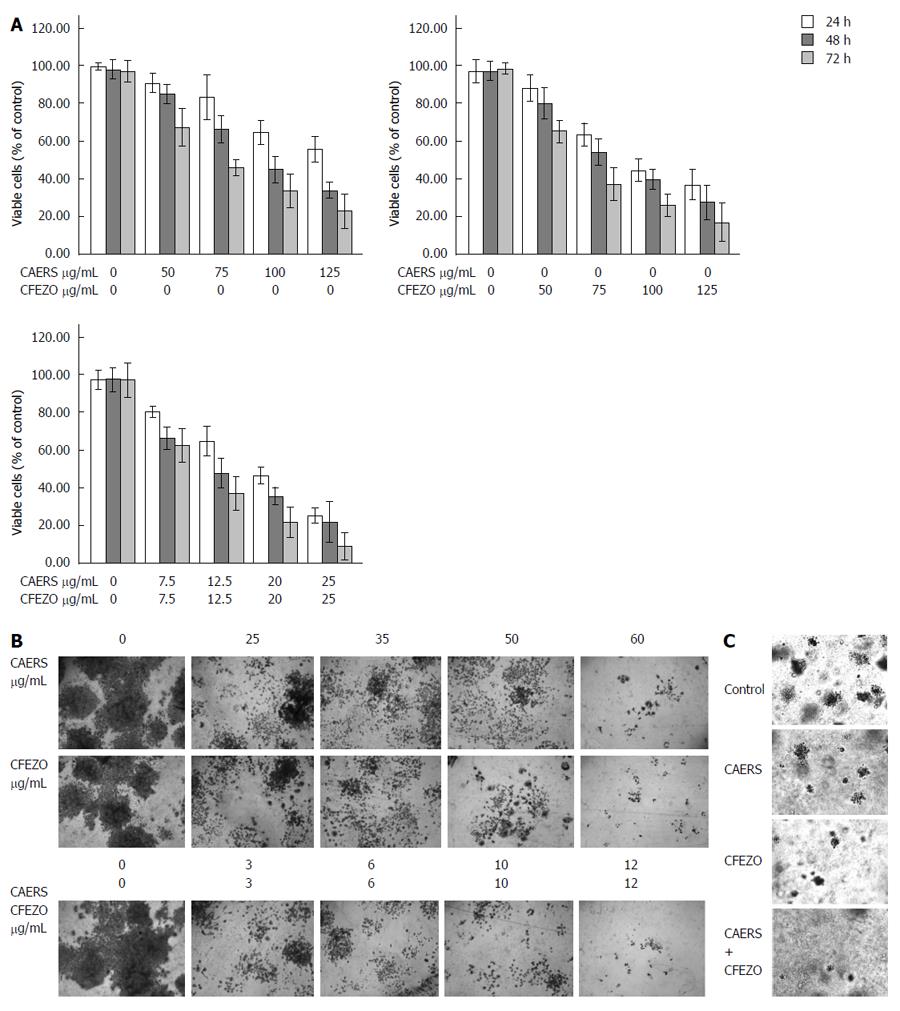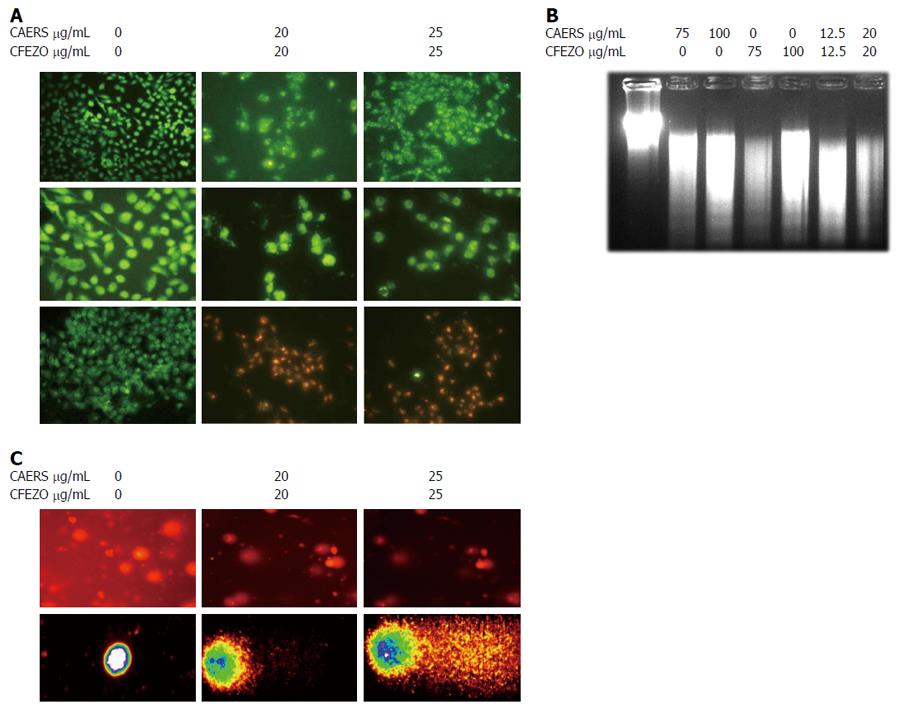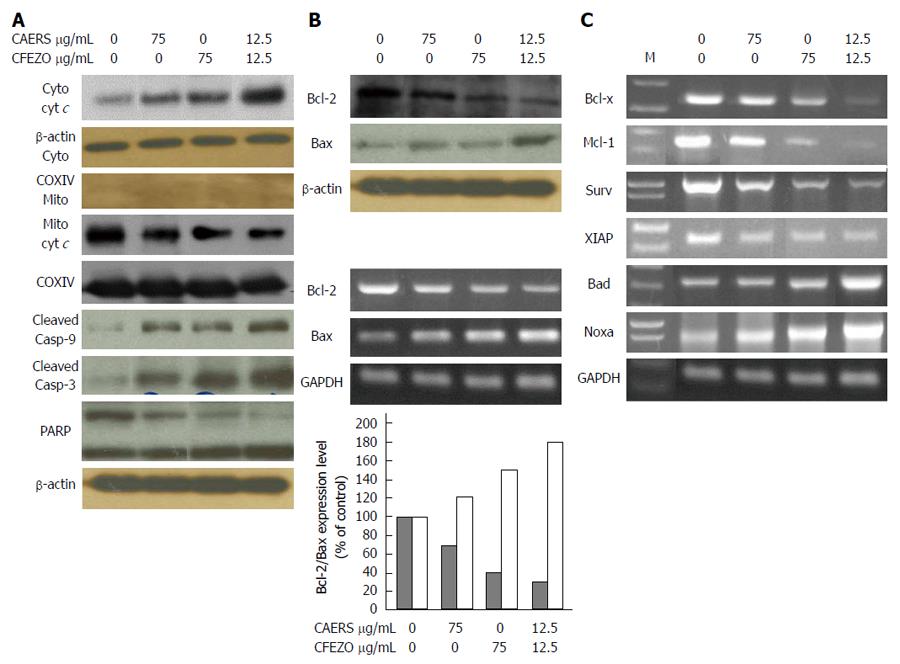Copyright
©2014 Baishideng Publishing Group Inc.
World J Gastroenterol. Nov 7, 2014; 20(41): 15275-15288
Published online Nov 7, 2014. doi: 10.3748/wjg.v20.i41.15275
Published online Nov 7, 2014. doi: 10.3748/wjg.v20.i41.15275
Figure 1 Combination of crude alkaloid and flavonoids acts synergistically to inhibit cell proliferation and colony formation in HCT116 cells.
A: Cell viability of HCT116 cells (5 × 104 cells/well) treated with the indicated concentrations of crude alkaloid extract of R. stricta (CAERS) and/or crude flavonoid extract of Z. officinale (CFEZO) for 24 h (white bars), 48 h (gray bars) and 72 h (light grey bars) were assess by trypan blue dye exclusion assay. The experiments were repeated five times in triplicates, and values are reported as the mean ± SD; B: For colony formation, HCT116 cells treated with the indicated concentrations of CAERS and/or CFEZO and counted under a dissection microscope and the experiment was repeated three times (magnification: × 6); C: Crystal violet staining of HCT116 cells grown in soft agarose assays to assess anchorage-independent growth. HCT116 cells were treated with CAERS (25 μg/mL), CFEZO (25 μg/mL), or a combination (3 μg/mL) for 2 wk (magnification: × 6).
Figure 2 Photomicrographs showing crude alkaloid and/or flavonoid treatments induced morphologic features of apoptosis in HCT116 cells.
Cell were treated for 48 h with indicated concentrations of crude alkaloid extract of R. stricta (CAERS) and/or crude flavonoid extract of Z. officinale (CFEZO) and observed with A: Light microscopy (first row: magnification × 20; second row: magnification × 40; third row: magnification × 63); B: Electron microscopy of toluidine blue-stained semithin sections (magnification: × 100); and C: Scanning electron microscopy (magnification: × 25026). Note deformed morphology of treated cells, blebbing of cellular membrane, granular surface and fragmentation of cells into apoptotic bodies.
Figure 3 Combination of crude alkaloid and flavonoid induce biochemical features of apoptosis.
HCT116 cells were treated for 24 h with indicated concentrations of crude alkaloid extract of R. stricta (CAERS) and/or crude flavonoid extract of Z. officinale (CFEZO) and assayed for existence of apoptotic cell death. A: Fluorescent images from Hoechst 33342 staining (first and second rows) or acridine orange/ethidium bromide (third row) (arrows indicate nuclear condensation, DNA fragmentation, and perinuclear apoptotic bodies) (magnification: first row: × 20; second and third rows: × 40); B: Agarose gel showing DNA fragmentation in HCT116 cells; C: Comet assay showing formation of DNA tail in CAERS and CFEZO-treated HCT116 cells. Nuclei with damaged DNA have the appearance of a Comet with a bright head and a tail, whereas nuclei with undamaged DNA appear round with no tail.
Figure 4 Crude alkaloid and flavonoid treatments trigger mitochondrial-dependent apoptotic pathway.
HCT116 cells were treated with indicated concentrations of crude alkaloid extract of R. stricta (CAERS) and/or crude flavonoid extract of Z. officinale (CFEZO) for 24 h. A: Western blots for apopototic proteins in cytosolic and mitochondrial fractions; B: Western blotting (top panel) and qRT-PCR analysis for Bcl-2 and Bax. The histogram depicts the Bcl-2 (dark bars) and Bax (white bars) mRNA ratio measured by using densitometric analysis; C: Ethidium bromide staining of antiapoptotic and proapoptotic gene products obtained from qRT-PCR. M, DNA ladder.
Figure 5 Crude alkaloid and flavonoid treatments modulate the expression of cell cycle-regulating proteins.
Western blot results for cell cycle-regulating proteins in HCT116 cells treated with indicated concentrations of crude alkaloid extract of R. stricta (CAERS) and/or crude flavonoid extract of Z. officinale (CFEZO) for 24 h.
-
Citation: Elkady AI, Hussein RAEH, Abu-Zinadah OA. Differential control of growth, apoptotic activity and gene expression in human colon cancer cells by extracts derived from medicinal herbs,
Rhazya stricta andZingiber officinale and their combination. World J Gastroenterol 2014; 20(41): 15275-15288 - URL: https://www.wjgnet.com/1007-9327/full/v20/i41/15275.htm
- DOI: https://dx.doi.org/10.3748/wjg.v20.i41.15275













